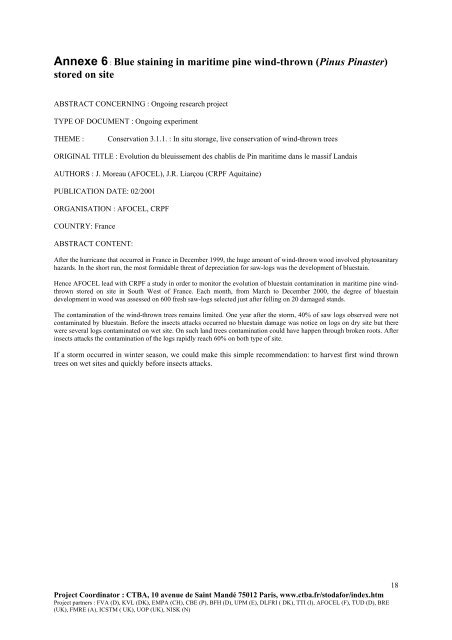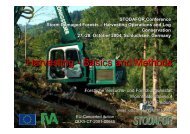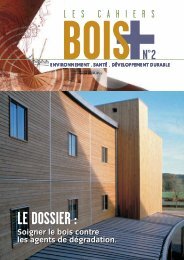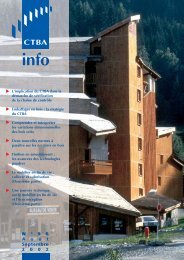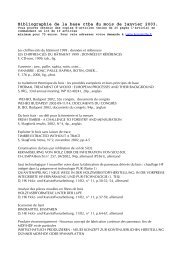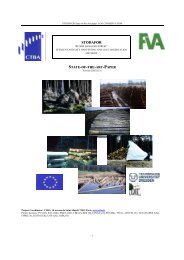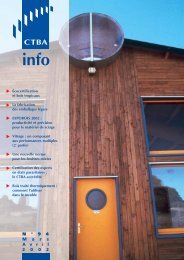Deliverable 6: List of ongoing experiments - Ctba
Deliverable 6: List of ongoing experiments - Ctba
Deliverable 6: List of ongoing experiments - Ctba
You also want an ePaper? Increase the reach of your titles
YUMPU automatically turns print PDFs into web optimized ePapers that Google loves.
Annexe 6 : Blue staining in maritime pine wind-thrown (Pinus Pinaster)<br />
stored on site<br />
ABSTRACT CONCERNING : Ongoing research project<br />
TYPE OF DOCUMENT : Ongoing experiment<br />
THEME : Conservation 3.1.1. : In situ storage, live conservation <strong>of</strong> wind-thrown trees<br />
ORIGINAL TITLE : Evolution du bleuissement des chablis de Pin maritime dans le massif Landais<br />
AUTHORS : J. Moreau (AFOCEL), J.R. Liarçou (CRPF Aquitaine)<br />
PUBLICATION DATE: 02/2001<br />
ORGANISATION : AFOCEL, CRPF<br />
COUNTRY: France<br />
ABSTRACT CONTENT:<br />
After the hurricane that occurred in France in December 1999, the huge amount <strong>of</strong> wind-thrown wood involved phytosanitary<br />
hazards. In the short run, the most formidable threat <strong>of</strong> depreciation for saw-logs was the development <strong>of</strong> bluestain.<br />
Hence AFOCEL lead with CRPF a study in order to monitor the evolution <strong>of</strong> bluestain contamination in maritime pine windthrown<br />
stored on site in South West <strong>of</strong> France. Each month, from March to December 2000, the degree <strong>of</strong> bluestain<br />
development in wood was assessed on 600 fresh saw-logs selected just after felling on 20 damaged stands.<br />
The contamination <strong>of</strong> the wind-thrown trees remains limited. One year after the storm, 40% <strong>of</strong> saw logs observed were not<br />
contaminated by bluestain. Before the insects attacks occurred no bluestain damage was notice on logs on dry site but there<br />
were several logs contaminated on wet site. On such land trees contamination could have happen through broken roots. After<br />
insects attacks the contamination <strong>of</strong> the logs rapidly reach 60% on both type <strong>of</strong> site.<br />
If a storm occurred in winter season, we could make this simple recommendation: to harvest first wind thrown<br />
trees on wet sites and quickly before insects attacks.<br />
18<br />
Project Coordinator : CTBA, 10 avenue de Saint Mandé 75012 Paris, www.ctba.fr/stodafor/index.htm<br />
Project partners : FVA (D), KVL (DK), EMPA (CH), CBE (P), BFH (D), UPM (E), DLFRI ( DK), TTI (I), AFOCEL (F), TUD (D), BRE<br />
(UK), FMRE (A), ICSTM ( UK), UOP (UK), NISK (N)


